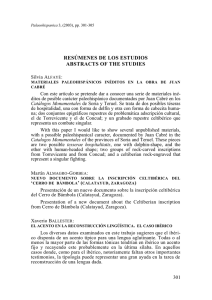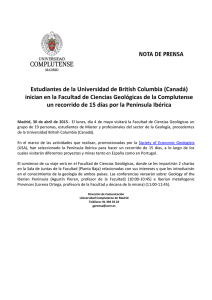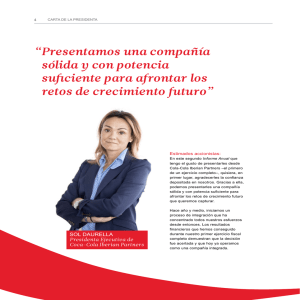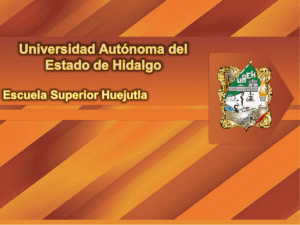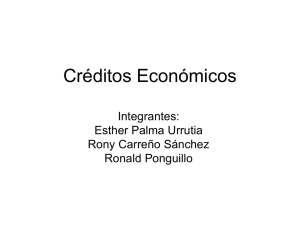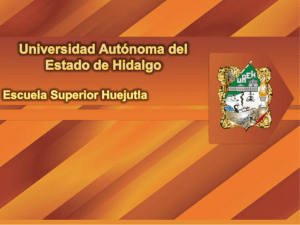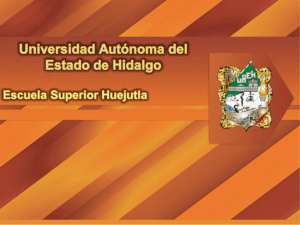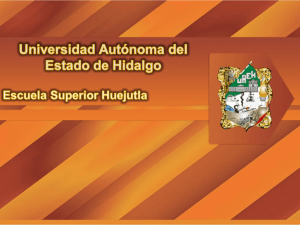13. Palabras clave y resúmenes de los estudios y novedades
Anuncio
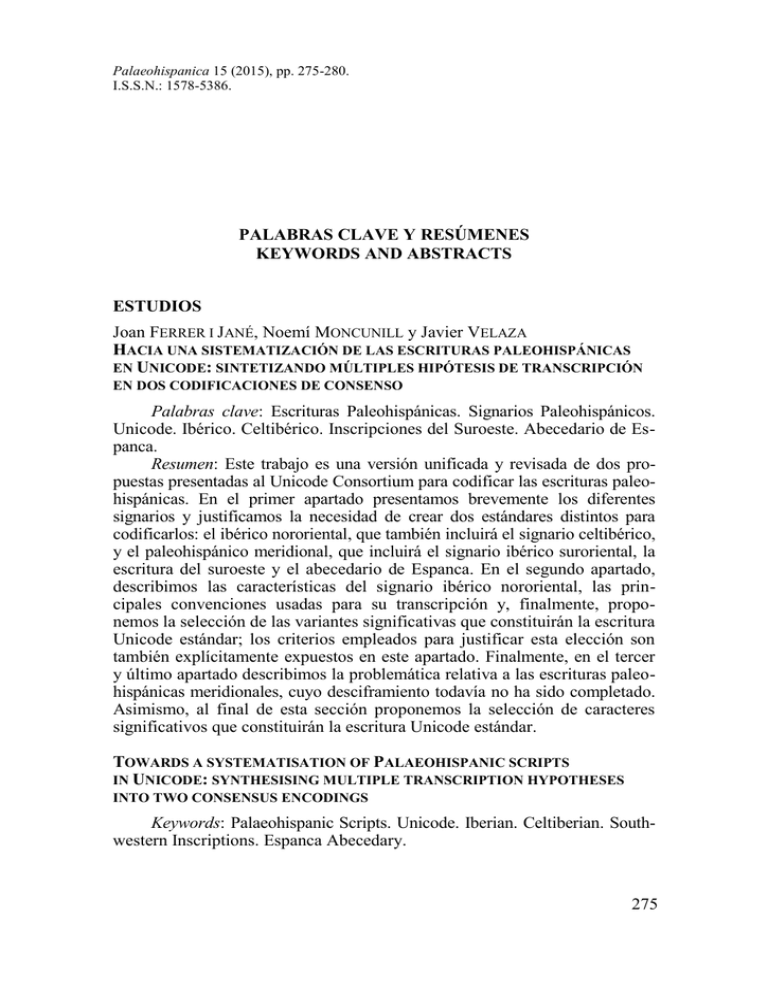
Palaeohispanica 15 (2015), pp. 275-280. I.S.S.N.: 1578-5386. PALABRAS CLAVE Y RESÚMENES KEYWORDS AND ABSTRACTS ESTUDIOS Joan FERRER I JANÉ, Noemí MONCUNILL y Javier VELAZA HACIA UNA SISTEMATIZACIÓN DE LAS ESCRITURAS PALEOHISPÁNICAS EN UNICODE: SINTETIZANDO MÚLTIPLES HIPÓTESIS DE TRANSCRIPCIÓN EN DOS CODIFICACIONES DE CONSENSO Palabras clave: Escrituras Paleohispánicas. Signarios Paleohispánicos. Unicode. Ibérico. Celtibérico. Inscripciones del Suroeste. Abecedario de Espanca. Resumen: Este trabajo es una versión unificada y revisada de dos propuestas presentadas al Unicode Consortium para codificar las escrituras paleohispánicas. En el primer apartado presentamos brevemente los diferentes signarios y justificamos la necesidad de crear dos estándares distintos para codificarlos: el ibérico nororiental, que también incluirá el signario celtibérico, y el paleohispánico meridional, que incluirá el signario ibérico suroriental, la escritura del suroeste y el abecedario de Espanca. En el segundo apartado, describimos las características del signario ibérico nororiental, las principales convenciones usadas para su transcripción y, finalmente, proponemos la selección de las variantes significativas que constituirán la escritura Unicode estándar; los criterios empleados para justificar esta elección son también explícitamente expuestos en este apartado. Finalmente, en el tercer y último apartado describimos la problemática relativa a las escrituras paleohispánicas meridionales, cuyo desciframiento todavía no ha sido completado. Asimismo, al final de esta sección proponemos la selección de caracteres significativos que constituirán la escritura Unicode estándar. TOWARDS A SYSTEMATISATION OF PALAEOHISPANIC SCRIPTS IN UNICODE: SYNTHESISING MULTIPLE TRANSCRIPTION HYPOTHESES INTO TWO CONSENSUS ENCODINGS Keywords: Palaeohispanic Scripts. Unicode. Iberian. Celtiberian. Southwestern Inscriptions. Espanca Abecedary. 275 Palabras clave y resúmenes - Keywords and abstracts Abstract: This work is a unified version of two proposals submitted to the Unicode consortium in order to encode the Palaeohispanic scripts. In the first section we briefly present these scripts and we justify the need to create two different standards to encode them: north-eastern Iberian, which will also include the Celtiberian script, and southern Palaeohispanic, which will include the south-eastern Iberian script, the south-western script and the Espanca abecedary. In section 2 we describe the specific characteristics of the north-eastern Iberian script, the main conventions used to transcribe it and, finally, we propose the selection of meaningful variants to be encoded as the standard script; the criteria to justify this choice are also explicitly expounded in this section. Finally, section 3 is devoted to describing the specific problematics concerning the southern Palaeohispanic scripts, whose decipherment has not yet been fully achieved. Likewise, at the end of this section we propose the set of all meaningful shapes to be encoded as the standard script. Javier HERRERA RANDO CULTURA EPIGRÁFICA Y ROMANIZACIÓN EN EL ÁMBITO IBÉRICO MERIDIONAL Palabras clave: Romanización. Cultura Epigráfica. Hispania Meridional. Resumen: Se plantean algunas reflexiones acerca de la configuración de la cultura epigráfica durante la época republicana en las zonas de uso de la epigrafía ibérica meridional y la influencia de Roma en dicho proceso. Para ello se analizarán en dichas zonas los cambios en los soportes y usos de la epigrafía, tratando de mantener una visión de conjunto en la que la eclosión de la epigrafía paleohispánica y la aparición de la latina son reflejos de un mismo fenómeno histórico. EPIGRAPHIC CULTURE AND ROMANIZATION IN SOUTHERN SPAIN Keywords: Romanization. Epigraphic Culture. Southern Spain. Abstract: Some thoughts have been raised about the configuration of the epigraphic culture during the Republican period in the areas where South-eastern Iberian script was used and the Roman influence on this process. To this aim, changes in epigraphic documents and the use of writing are analysed, trying to keep an overall vision in wich the expansion of the paleohispanic epigraphy and the appearance of the Latin one are two sides of the same historic process. Ignacio SIMÓN CORNAGO ΤREINTA AÑOS DE INVESTIGACIONES SOBRE LA INSCRIPCIÓN MUSIVA DE CAMINREAL (HISPANIA CITERIOR; MLH E.7.1 = K.5.3) Palabras clave: Lengua ibérica. Inscripción sobre Mosaico. Firma de Artesano. Opus Signinum. Musiuarius. 276 PalHisp 15 Palabras clave y resúmenes - Keywords and abstracts Resumen: estado de la investigación sobre la inscripción ibérica en opus signinum de La Caridad (Caminreal). Se analiza la copiosa bibliografía que existe sobre este epígrafe organizada en cuatro apartados principales: el antropónimo likine; el término ekiar; el topónimo; y la identidad de likine. THE MOSAIC INSCRIPTION FROM CAMINREAL (HISPANIA CITERIOR; MLH E.7.1 = K.5.3): THIRTY YEARS OF RESEARCH Keywords: Iberian Language. Mosaic Inscription. Signature Craftsman. Opus Signinum. Musiuarius. Abstract: Status of the issue of mosaic Iberian Inscription from the archaeological site of La Caridad (Caminreal). This paper analyzes the extensive bibliography of this inscription, organized in four principal sections: the name likine; the term ekiar; the place name; and the likine’s indentity. NOVEDADES Isidro AGUILERA ARAGÓN y Carlos JORDÁN CÓLERA DOS NUEVOS GRAFITOS CELTIBÉRICOS PROCEDENTES DE BURZAU (BORJA, ZARAGOZA) Palabras clave: Grafitos Celtibéricos. Burzau. Borja (Zaragoza). Resumen: Se presentan dos nuevos grafitos celtibéricos procedentes de Burzau (Borja, Zaragoza). TWO NEW CELTIBERIAN GRAFFITI FROM BURZAU (BORJA, ZARAGOZA) Keywords: Celtiberian Graffiti. Burzau. Borja (Zaragoza) Abstract: The paper provides two new celtiberian graffiti from Burzau (Borja, Zaragoza). Joan FERRER I JANÉ y Vicent ESCRIVÀ TORRES TRES NUEVAS INSCRIPCIONES IBÉRICAS DEL MUSEO ARQUEOLÓGICO DE LLÍRIA Palabras clave: Lengua Ibérica. Escritura Ibérica. Inscripción Ibérica. Liria. Sinarcas. Benagéber. Resumen: Este trabajo analiza tres inscripciones ibéricas presentes en objetos recientemente donados al Museo Arqueológico (Llíria). Un fragmento de una lámina de plomo y un pequeño objeto de plomo supuestamente ambos procedentes del Tossal de Sant Miquel de Llíria, y un fragmento de un pequeño vaso de cerámica con tapa dentada supuestamente procedente del yacimiento del Charco Negro (Sinarcas / Benagéber) que presenta una interesante inscripción realizada antes de la cocción que marca el punto correcto de cierre. Aunque existe una cierta tradición de falsificaciones en el entorno de Llíria, en ausencia de indicios claros de falsificación, nos inclinamos a considerar que se trata de piezas auténticas. PalHisp 15 277 Palabras clave y resúmenes - Keywords and abstracts THREE NEW IBERIAN INSCRIPTIONS FROM THE LLÍRIA ARCHAEOLOGICAL MUSEUM Keywords: Iberian Language. Iberian Writing. Iberian Inscriptions. Liria. Sinarcas. Benagéber. Summary: This paper analyses three Iberian inscriptions present on objects recently donated to the Archaeological Museum of Lliria. A fragment of a lead plaque and a small lead objet allegedly both found at the Tossal de Sant Miquel (Lliria), and a fragment of a small ceramic vase with serrated cover, allegedly found at the site of Charco del Negro (Sinarcas / Benagéber) with an interesting inscription done before heating, which marks the correct closing point. Although there is a certain tradition of fakes on the environment of Llíria, in the absence of clear signs of forgery, we are inclined to believe that they are genuine pieces Joan FERRER I JANÉ, Alberto J. LORRIO ALVARADO y J. VELAZA LA INSCRIPCIONES IBÉRICAS EN ESCRITURA SURORIENTAL DEL CASTELLAR DE MECA (AYORA) Palabras clave: Inscripción Ibérica. Lengua Ibérica. Escritura Ibérica Suroriental. Meca. Ostrakon. Lámina de Plomo. Cerámica Pintada. Resumen: En este trabajo se analizan tres inscripciones ibéricas procedentes del Castellar de Meca (Ayora, Valencia), todas ellas en escritura ibérica suroriental. Una, ya conocida, sobre cerámica pintada, que Pierre Paris llevó al Louvre a principios del siglo XX, y dos pequeñas inscripciones inéditas procedentes de una colección particular: un pequeño fragmento de lámina de plomo y un pequeño ostrakon de cerámica. Para la inscripción pintada, se propone una lectura alternativa más respetuosa con la paleografía del texto que la lectura tradicional. Por lo que respecta al texto de la lámina de plomo, aunque solo tiene tres signos, se pueden establecer claros paralelismos con la lámina de plomo del Llano de la Consolación (Montealegre del Castillo, Albacete). Finalmente, sin descartar otras opciones, el contenido del ostrakon podría ser de tipo metrológico. THE IBERIAN INSCRIPTIONS IN SOUTH-EASTERN SCRIPT FROM THE CASTELLAR DE MECA (AYORA) Keywords: Iberian Inscription. Iberian Language. South-eastern Iberian Script. Meca. Ostrakon. Lead Sheet. Painted Pottery. Summary: This paper analyses three south-eastern Iberian inscriptions from Castellar de Meca (Ayora, Valencia): the first is a painted inscription brought by Pierre Paris to the Louvre Museum in the early twentieth century; the others are two small unpublished inscriptions from a private collection: a small lead sheet and a small ceramic ostrakon. In the case of the painted inscription, we propose an alternative reading more respectful with the text palaeography. In the case of the text of the lead sheet, although it only con278 PalHisp 15 Palabras clave y resúmenes - Keywords and abstracts tains three signs, clear parallels with the lead plaque of Llano de la Consolation (Montealegre del Castillo, Albacete) can be established. Finally, the meaning of the ostrakon text could be of metrological type. María GARCÍA-BARBERENA, Mercedes UNZU y Javier VELAZA ESGRAFIADO EN SIGNARIO PALEOHISPÁNICO HALLADO EN PAMPLONA Palabras clave: Inscripción Paleohispánica. Territorio Vascón. Pompelo. Resumen: En este trabajo presentamos una inscripción paleohispánica sobre cerámica hallada en Pamplona y analizamos el signario que emplea y la lengua en que pudiera estar escrita. A NEW PALAEOHISPANIC GRAFFITO FROM PAMPLONA Keywords: Palaeohispanic inscription. Vasconian territory. Pompelo. Abstract: In this paper we present a Palaeohispanic inscription on pottery found in Pamplona and we analyse the writing system and the language in which it is written. Aránzazu LÓPEZ FERNÁNDEZ NOTA SOBRE LA INSCRIPCIÓN “IBÉRICA” DE ELDA (G.11.1) Palabras Clave: Epigrafía Paleohispánica. Epigrafía Bizantina. Corpus Paleohispánico. Elda (Alicante) Resumen: Con esta nota se pretende corregir una adscripción errónea como epígrafe paleohispánico para la inscripción G.11.1 procedente de la necrópolis de El Monastil de Elda (Alicante) que posee una cronología posterior. NOTE ABOUT THE “IBERIAN” INSCRIPTION FROM ELDA (G.11.1) Keywords: Paleohispanic Epigraphy. Byzantine Epigraphy. Paleohispanic Corpus. Elda (Alicante) Abstract: The main concern of this note is to correct a wrong attribution for the inscription G.11.1 from the necropolis El Monastil at Elda (Alicante) that until now has been assumed to be a paleohispanistic inscription, even though it has a later chronology. Juan Carlos OLIVARES PEDREÑO NUEVA INTERPRETACIÓN DE CUATRO INSCRIPCIONES VOTIVAS DE SORIA Y LA RIOJA Palabas clave: Epigrafía. Religión Romana. Celtiberia. Aras Votivas. Divinidades. Resumen: En el presente trabajo, llevamos a cabo el estudio de cuatro altares votivos procedentes de las provincias españolas de Soria y La Rioja cuyas lecturas, hasta el momento, no habían sido plenamente satisfactorias. Tras un detenido análisis de las piezas sobre el terreno, revisamos sus lectuPalHisp 15 279 Palabras clave y resúmenes - Keywords and abstracts ras, ofrecemos nuevo material gráfico y proponemos cambios relevantes en los nombres y apelativos de las deidades, así como en la interpretación general de varios de los textos. NEW INTERPRETATION OF FOUR VOTIVE INSCRIPTIONS FROM SORIA AND LA RIOJA Keywords: Epigraphy. Roman Religion. Celtiberia. Votive Altars. Divinities. Abstract: In this paper, we study four votive altars from the Spanish provinces of Soria and La Rioja. The interpretation of these epigraphs has not been completely satisfactory up to the present. After an analysis of the monuments, we propose changes in the lecture of the theonyms, epithets and in the general structure of the inscriptions. Margarita TORRIONE, Javier DE HOZ y Carmelo FERNÁNDEZ IBÁÑEZ UN DOBLE SELLO SOBRE CERÁMICA INDÍGENA DE ÉPOCA ALTOIMPERIAL HALLADO EN DESSOBRIGA (OSORNO, PALENCIA / MELGAR, BURGOS) Palabas clave: Dessobriga. Yacimiento Arqueológico. Cerámica Vaccea. Cerámica Celtibérica. Cerámica Altoimperial. Sello sobre Cerámica. Epigrafía Celtibérica. Latinización del Territorio Vacceo. Escritura en Territorio Vacceo. Restauración de Cerámica Antigua. Resumen: Un doble sello inédito, de apariencia epigráfica, sobre cerámica vaccea de época altoimperial, hallado en el yacimiento arqueológico de Dessobriga, Osorno la Mayor (Palencia) / Melgar de Fernamental (Burgos), en curso de excavaciones desde 2014. Contexto del hallazgo, estudio epigráfico y proceso de restauración. A DOUBLE STAMP ON INDIGENOUS EARLY ROMAN EMPIRE POTTERY FROM DESSOBRIGA (OSORNO, PALENCIA / MELGAR, BURGOS) Keywords: Dessobriga. Archaeological Site. Vaccean Pottery. Celtiberian Pottery. Early Empire Pottery. Pottery Stamp. Celtiberian Epigraphy. Latinisation of the Vaccean Territory. Writing in Vaccean Territory. Restauration of Ancient Pottery. Abstract: An unpublished, at first view epigraphic, double stamp on Early Roman Empire Vaccean pottery found at the archaeological site of Dessobriga (Osorno la Mayor, Palencia / Melgar de Fernamental, Burgos), in course of excavation since 2014. Context of the find, epigraphic study and restoration process. 280 PalHisp 15
